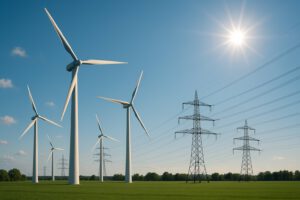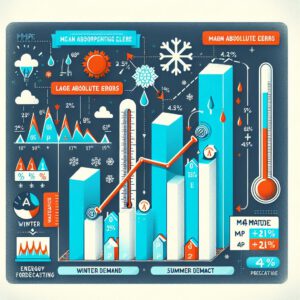At alitiq, we know that the energy transition is in full swing. However, with the increasing use of renewable energies like solar and wind, a significant challenge arises: uncertainty. We’re not talking about everyday uncertainty, but rather the kind that can directly impact the stability of your power grid! But rest assured, we offer intelligent solutions to make the future more precise.
Uncertainty Quantification in Renewable Energy Forecasting: A Guide to Smarter Predictions in 2025
Renewable energies form the backbone of our sustainable energy ecosystem. However, their inherent variability – like the fluctuating availability of sunlight and wind – presents a considerable challenge: uncertainty. Effectively managing this uncertainty can help improve power grid stability, reduce costs, and foster efficient resource allocation. In this article, we will explore Uncertainty Quantification (UQ) in renewable energy forecasting, examining its sources, methods, and benefits. Let’s delve into this promising field! 🚀
Sources of Uncertainty in Renewable Energy Forecasting
Uncertainty in renewable energy forecasting results from a combination of intrinsic variability and prognostic limitations:
- Weather Conditions: Parameters such as solar irradiance, wind speed, and cloud cover can fluctuate unpredictably. An example of this would be planning the power production of a solar park, which is influenced by unexpected cloud formations.
- Model Limitations: No forecasting model is flawless; inaccuracies in data, assumptions, or algorithms can introduce bias. This is evident when a computer model overestimates the yield of a wind farm due to outdated wind data, leading to planning deficiencies.
- External Factors: Inefficiencies in equipment, environmental impairments (e.g., icing of wind turbines), or unplanned downtime can further increase complexity.
A deep understanding of these uncertainties is essential to developing robust methods for their quantification and management.
Methods of Uncertainty Quantification: A Comprehensive Overview
UQ involves estimating the range of possible outcomes for renewable energy generation. This can be achieved through various approaches, each tailored to specific scenarios. Here is a detailed overview:
Model-Agnostic Uncertainty Quantification
This approach focuses on historical forecast errors rather than the underlying model itself. By analyzing past forecast accuracy, the probable bounds of future predictions can be estimated.
How it works:
- Historical forecast data is collected and compared with actual outcomes.
- Statistical models (e.g., Gaussian distributions, quantile regression) are used to estimate the uncertainty range.
Advantages:
- Simple and implementable across various forecasting models.
- Requires no knowledge of the internal workings of the predictive models.
Disadvantages:
- Heavily dependent on the quality and availability of historical data.
- May not adapt well to new trends or changing conditions.
Example: If historical errors show a consistent deviation of ±10% from the predicted wind energy output, this range can be factored into future forecasts to enable more precise planning. This provides the grid operator with a better estimate of the minimum wind power yield.
Ensemble Generation via Weather Forecasts
Weather forecasts are often the primary input for renewable energy predictions. The use of ensembles – i.e., multiple forecasts from slightly varied initial conditions – helps capture the variability inherent in weather forecasts.
How it works:
- Multiple weather forecasts (ensembles) are generated using variations in initial atmospheric conditions.
- These forecasts are fed into renewable energy models to create a range of possible energy yields.
Advantages:
- Provides a dynamic and scenario-based approach to uncertainty.
- Captures non-linear relationships between weather inputs and energy output.
Disadvantages:
- Computationally intensive due to the need for multiple simulations.
- Dependent on the accuracy of the underlying weather models.
Example: An ensemble weather forecast might predict wind speeds ranging from 5 to 15 m/s, leading to energy yields between 100 MW and 300 MW. Planners can thus prepare for all scenarios and, for example, schedule the deployment of gas power plants or storage facilities in advance to compensate for fluctuations.
Historical Data and Machine Learning (Hybrid Approach)
Combining historical error patterns with advanced Machine Learning (ML) models can create adaptive uncertainty bounds.
How it works:
- ML models are trained with historical forecast data to predict error ranges.
- New data (e.g., updated weather forecasts) are integrated to refine predictions.
Advantages:
- Highly adaptable to evolving patterns.
- Can uncover complex relationships that traditional methods might miss.
Disadvantages:
- Requires large, high-quality datasets.
- Model training can be resource-intensive.
Example: A neural network could learn that cloudy weather combined with low wind speeds tends to lead to higher forecast errors for solar farms. It could then dynamically predict uncertainty and, for instance, optimize the procurement of balancing energy on the spot market when higher uncertainties are expected.
Benefits of Uncertainty Quantification in Renewable Energy
Quantifying uncertainty is not merely about risk mitigation; it also opens up a range of opportunities:
- Improved Grid Management: Grid operators can better prepare for variability and maintain grid stability.
- Optimized Financial Planning: Precise risk assessments support energy pricing and contract management. This enables, for example, the submission of more accurate bids for the supply of green electricity, as possible yield fluctuations can be better estimated.
- More Efficient Storage Solutions: The use of battery storage can be planned more efficiently with knowledge of possible fluctuations. For instance, a battery storage system can be charged or discharged precisely when the uncertainty regarding solar or wind yield is greatest, in order to stabilize the grid.
- Informed Policy Making: Decision-makers can develop better-informed political measures for the integration of renewable energies.
The Future of UQ in Renewable Energy
As the adoption of renewable energies accelerates, UQ methods will become increasingly sophisticated. Innovations such as AI-driven prediction models, integration with IoT devices, and real-time ensemble generation will further enhance accuracy.
Investing in robust UQ systems today ensures a more resilient, efficient, and sustainable energy future.
Key Insights
- Uncertainty in renewable energy forecasting results from weather variability, model errors, and external factors.
- Model-agnostic methods, weather ensemble approaches, and hybrid ML techniques are effective tools for uncertainty quantification.
- Precise uncertainty quantification leads to improved grid management, optimized financial planning, and more informed political decisions.
Are you ready to master the uncertainty in your energy planning? Let’s shape the future of the energy industry together!





